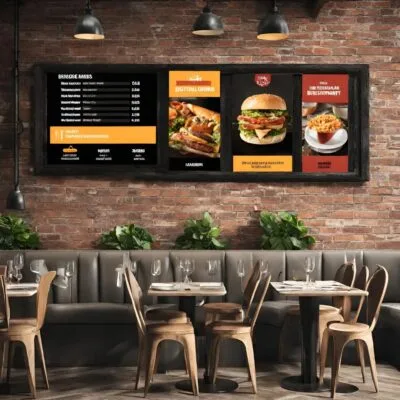A quick-service restaurant (QSR), commonly known as a fast-food establishment, is a place that serves affordable meals, offering fast service and limited table assistance. Customers at QSRs prefer quick order processing for timely meal delivery. The advantages of digital menu boards become evident in this context, facilitating a fast-ordering process, shorter queues, and increased profitability in the Quick Service Restaurant (QSR) industry. Recent data has disclosed that 8 out of 10 consumers have entered a store because a sign caught their interest, and the adoption of digital signage leads to a 31.8% increase in overall sales volume. Read on to explore the advantages of digital signage and their application to your business.
Benefits of Utilizing Premium Digital Menu Boards for Restaurants:
As is widely recognized, customers often begin their decision-making process by reviewing menus. Whether in the form of static paper signs or digital screens, signage is a crucial asset in any business. When implemented effectively, digital signage offers a cost-effective means to reduce customer wait times, boost foot traffic, and more. Here are the key advantages of digital menu boards, accompanied by interesting facts:
Lessen Perceived Wait Times:
After placing orders, customers experience a brief waiting period, during which time seems to pass slowly. Digital signage with exciting animations and consistent motion engages customers, diverting their attention from the wait and effectively reducing perceived wait times, resulting in greater satisfaction upon receiving their orders.
Moving the Lines Quickly:
Frequent encounters with customers are common in quick-service restaurants that employ static menu signs. Given that visuals are processed 60,000 times faster than text (according to 3M), digital menu boards present menus with a clean layout and attractive visuals, helping customers make informed decisions quickly and accelerating the queue.
Improve Customer Experience:
The process of locating and ordering desired items significantly influences customer satisfaction in restaurants, grocery stores, and other retail and hospitality surroundings. Approximately three-quarters (74%) of restaurant patrons consider an easy-to-read menu as their top priority for a positive experience. Digital displays breathe life into restaurant menus with videos and animations, offering an ideal solution to enhance the ordering experience.
Improve Customers’ Buying Decisions:
Nearly 30% of customers find digital menus influential in their purchasing decisions. Digital menu boards, unlike printed signs, quickly grab attention and effectively promote menu items with images, videos, and animated effects. Displaying limited-time offers, special promotions, and best-selling items encourages customers to make purchases.
Simply Update Prices and Digital Menu Board Items:
Nento’s digital menu boards provide businesses with the flexibility and comfort of remotely managing menu items and prices based on supply and demand, promotional campaigns, and upcoming events. Additionally, they offer the option to push updates to all or selected restaurants. This ability to optimize price points and deliberately promote high-demand items helps drive sales and increase profits.
Animation With Great Resolution And Dazzling Colors:
According to the Nielsen Norman Group, animations capture attention, especially in customers’ peripheral view. Digital signage uses unique designs, special effects, bright colors, and high resolution to make menu items, photos, and videos visually appealing.
Respond Quickly and Manage Easily:
In the dynamic business climate, quick service restaurants (QSRs) need the ability to respond quickly to changes. Well-designed digital menu content serves as an effective way to introduce customers to lesser-known menu items and has the ability to easily change item line-ups, including limited-time offers.
Encourage Upselling by Digital Menu Boards:
Digital signage creates an opportunity for upselling by displaying complementary items based on orders entered in a POS system. This proves particularly effective for restaurants offering combos and menu add-ons like sides, drinks, and desserts.
Sponsor at the Right Time:
Digital menu displays enable effective delivery of diverse marketing content at the right time. Scheduled publishing allows businesses to plan and publish future promotions, ensuring timely and impactful communication with customers. Restaurants can promote test items without incurring additional costs for creating new posters and signs.
No Printing Costs with Digital Menu Boards:
While static menu boards require printing and installation costs, digital signage eliminates these expenses, promoting environmental sustainability.
Automate Menu Variations:
Digital signage allows QSRs to display different menus based on the time of day and day of the week. The Dayparting feature automates the process of switching between breakfast, lunch, and dinner menus
Uphold Brand Reliability with Digital Menu Boards:
Brand consistency is crucial for successful marketing. Digital menu boards help maintain consistency across multiple locations, ensuring that the same menus are displayed everywhere. This scalable and easily manageable solution helps establish credibility and leaves a lasting impression on customers.
Conclusion:
The restaurant industry has witnessed a transformative shift with the adoption of technology, particularly digital displays, enhancing the overall customer experience. Traditional posters and notice boards have become old-fashioned, making way for innovative solutions like digital signage. Restaurants leveraging technology can better provide for various customer needs, visually connecting consumers to the operations of the business. In the ever-changing landscape, digital menu boards provide unlimited opportunities, controlled only by the limits of imagination.



